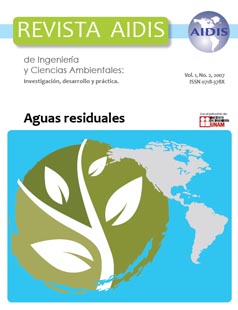Uso de ozônio para melhoria do tratamento biológico de efluentes da indústria de celulose
Main Article Content
Abstract
The paper investigates the use of ozonization to remove recalcitrant compounds and improve the biotreatability of alkaline effluents of ECF bleaching of eucalyptus kraft pulp. These effluents have low biodegradability and ozonization promotes an improvement of this biodegradability, especially due to an increase in BOD5 and a slight reduction of COD. The tests were carried out in two samples (Effluent A and Effluent B). The influence of pH (10.9 and 7) and temperature (35 and 70ºC) parameters were evaluated in Effluent A, and the influence of hydrogen peroxide in ozonization (doses of 0.7, 2, 4 and 10 mM) was evaluated in Effluent B. The data were subjected to statistical analysis through multiple linear regression. A COD removal up to 20% with a combination of 20 mM of O3, at a pH of 10.9 and a temperature of 70ºC was noticed in Effluent A. Removals of COD, TOC, color and carbohydrates improved as the ozone dose was increased. There was a 92% increase in biodegradability (BOD5/COD) with an ozone dose of 10 mM, at a pH of 10.9 and a temperature of 70ºC. Acute toxicity dropped with the increase in the O3 dose. There was a COD removal up to 21% with the combination of 20 mM of O3 and 4 mM of H2O2 in Effluent B. The increase in the ozone dose affected more significantly the removals of COD, TOC and color than the increase in the H2O2 dose, where a slight influence of H2O2 was noticed for a same dose of ozone. There was an increase in biodegradability up to 63% with an ozone dose of 10 mM and a H2O2 dose of 4 mM. Acute toxicity increased slightly with a higher dose of O3 for doses of 2 and 4 mM of H2O2, but dropped subsequently, with the toxic effect being eliminated at 2 mM of O3, regardless of the H2O2 dose. A slight TOC removal was noticed with a maximum value of 7% in 4 mM doses of H2O2 and 20 mM doses of O3. The small TOC loss indicated that although the organic matter was being oxidized, which was indicated by the increase in the oxidation state and by the COD removal, it was not mineralized because mineralization should be attained by biological treatment rather than by chemical treatment, due to the lower costs of biological treatment.
Article Details
How to Cite
[1]
Morais, A. de A., Honor Mounteer, A., Abrantes Silveira, D.S., Regazzi, A.J., Dutra Brandão, F. and Almeida de Oliveira, J. 2009. Uso de ozônio para melhoria do tratamento biológico de efluentes da indústria de celulose. Revista AIDIS de ingeniería y ciencias ambientales: Investigación, desarrollo y práctica. 1, 2 (Nov. 2009).


